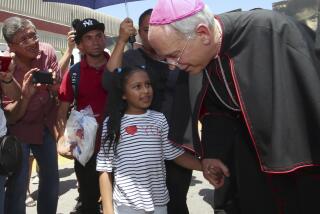Nuns Find Farm Life Pastoral--and Maybe Profitable : Enterprise: Shoveling sawdust and stacking hay, the 53 sisters at Mount St. Mary’s Abbey supplement their candy business by raising heifers.
- Share via
WRENTHAM, Mass. — Hanne-Marie straddles the fidgety calf’s neck and guides its thrashing head toward a bucket of milk. The sun is high. It’s hot outside, but in the barn it is stifling and the flies are persistent.
Up to her knees in hay and with sawdust coating her work clothes, Hanne-Marie alternately dips a finger into the bucket and the days-old calf’s mouth. She is teaching it how to drink on its own.
Though it is not yet noon, Hanne-Marie has been up for hours. But frowns never interrupt her smiles. This is her vocation. At least a small part of it.
Hanne-Marie is a Trappestine nun. And at Mount St. Mary’s Abbey, where she has been cloistered for two years with 52 others in the rolling green hills of Wrentham, the sisters raise heifers to help support themselves. There is a mail-order candy business too.
While the nuns have for decades made fudge and other candy to keep the abbey running, they still are learning about this business of raising replacement heifers for dairy herds.
Until the spring, the nuns were dairy farmers, tending a herd of 50 milk cows, collecting tanks of milk to be pasteurized and sold.
But slowly, grain prices rose and the profits shifted to losses--like so many smaller dairy farms in a farm economy that rewards bigness. The milking herd was sold off.
“The economy did us in,” said Mother Superior Agnes Day.
So, after 46 years, another plan was put together.
The switch to heifer-raising was logical, with the large barn, grazing fields and rows of corn for feed already in place. The nuns buy calves, raise them until they have one of their own and sell the mother. If the calf is a bull, it is sold too.
“In the beginning the heifers were breaking out all the time and ending up in the industrial park down the road,” says Sister Miriam, putting a hand to her habit and shaking her head. “And the police would come.”
Then there was the “stampede,” Sister Maureen recalls. “All we did for two hours was run after the cows.”
And when the 1,000-pound beasts decide among themselves that one grazing pasture looks more appetizing than another and lumber away, “it’s easier to just let them,” she says. Cows have no discipline.
The work is hard. And most of the nuns were not farm girls to start with, Sister Agnes Day says. But “some members of the community feel it provides a good balance for an intense life of prayer.”
The nuns have some help from a few neighbor volunteers, but mostly take care of things themselves. One taught herself to weld so she could make steel-barred pens for the calves.
“It’s amazing what you can do if you have it in your head that you can do it,” Sister Miriam says.
The chores are divided. Some nuns shovel sawdust and hay for bedding, others clean the stalls. All help stack the bales of hay to the towering rafters of the barn to get the herd--now numbering 65--through the winter.
But as time-consuming as the farm--and the candy business--may be, the work is only a part of life at the abbey.
The days begin at 3 a.m., and for the first five hours there is mostly prayer in the chapel. Then, until the lights go out at 8 p.m., work, meals and chores are fit in among periods of prayer.
“The whole day is integrated in a very real way through the focus on prayer,” says Sister Maureen.
It’s part of the Cistercian order, which was founded in France in the 11th Century and stresses self-knowledge.
Hanne-Marie, who was a journalist in Norway until hearing her call, says her former career helps her as she prepares to take her final vows.
“I use everything I learned in journalism, like the critical thinking about sources, listening, using your senses,” she says. “Now, I use it on myself, on my thoughts.”
In the hours spent working, when Hanne-Marie and others head to the barn, others file into the buttery-sweet-smelling candy house on the abbey’s nearly 600 acres.
The candy business was started in 1956, about seven years after the abbey was founded out of St. Mary’s in Waterford, Ireland.
“It has built up from one kettle and wrapping caramels by hand to a big business with a lot of automation,” Sister Agnes says.
She says the candy records and orders are now computerized and the nuns plan to advertise on the World Wide Web.
Sister Rita, who directs the candy operation, says the nuns will turn out about 12 tons of candy this year, including more than 850 12-pound cases of the best-selling “munch,” a decadent concoction of butter toffee, milk chocolate and walnuts.
The sisters also produce fudge and penuche, chocolate-covered caramels, milk-chocolate bars and suckers and almond bark. Some is sold in gift boxes, with jams produced by a monastery in Spencer.
So many orders flood in for Christmas, the nuns are already shifting into a six-day production schedule.
In each box of candy is a small, hand-lettered flyer urging the buyer to share and explaining that, besides the fresh cream and butter, the ingredients are “monastic joy and a concern for the whole pattern of family and friendship in your life.”
More to Read
Inside the business of entertainment
The Wide Shot brings you news, analysis and insights on everything from streaming wars to production — and what it all means for the future.
You may occasionally receive promotional content from the Los Angeles Times.










